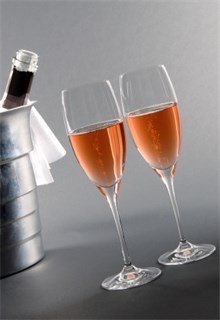
About Pink Champagne
Pink / Rosé Champagne was never originally intended to be taken seriously, something frivolous and unnecessary therefore always remaining in the shadows of its more ‘successful relative’.
Before the Champagne Method for creating the sparkling wines this region became so famous for was ‘invented’, originally wines from Champagne were ‘still’ with both red and white wines being produced. One of the areas for quality red wines at this time was ‘Bouzy’, situated in the mountains above Reims, it was a favourite of Louis the Fourteenth of France.
It was made from the Pinot Noir grape variety and although was created mostly for local drinking, it became a regular feature on Royal banqueting tables. Bouzy red wine was also added occasionally to Champagne for fun and became popular for celebrations and festivals. Eventually this caught on and became fashionable throughout France and other ‘Champagne drinking countries’. So adding only red wine from Bouzy to Champagne for the creation of Champagne Rosé became a tradition.
Style
The making of Rosé Champagne by adding red wine to make it pink is still the most popular way of production within the Champagne region and is an anomaly because in France it is the only wine region where this is allowed. All other Rosé wines have to be created by macerating the wine on the skins of red grape varieties for a short period to give the wine its pink colour. This is called the Saignée or ‘bleeding’ method. It is always a discussion point for those aficionados of Pink Champagne as to which method makes the best quality wine, though at many ‘blind tastings’ arranged for this purpose, a firm conclusion has not yet been reached!
However a few of the more celebrated Champagne Houses still regard the Saignée method as the only certain way to create the finest quality Rosé Champagne, these include Louis Roederer Cristal Rose and Laurent Perrier Cuvee Rose. The Houses that prefer adding small quantities of red wine do so mainly because it is easier to control the colour, so as to always achieve the continuity of style they rely on and are famous for.
Rosé Champagne has moved a long way over time in terms of recognition in the Champagne market place and is now no longer the poorer cousin. Today it commands high prices and has certainly established a firm position as an individual style in its own, worldwide.
The three grape varieties that go make all Champagne are still used but it is the two black grapes – Pinot Noir and Pinot Meunier that are used to give colour when the Saignée method is used, but predominantly Pinot Noir. The white grape variety used in Champagne production is Chardonnay.
[Note: Remember that all grape juice is clear, the colour of wine is denoted by the colour of the grape skins]
Matching Rose Champagne with Food
Just about everything goes with Champagne from the finest smoked salmon or lobster to the British classic Fish and Chips. With Rose Champagne perhaps we can be a bit more definitive. Try some simple canapés of neat rounds of pan fried French bread crisped in olive oil, spread with cream cheese and top with a freshly cooked tiger prawn.
Try cured ham such as Parma from Italy, French Bayonne, Iberico from Spain or find a locally produced one to you - Thinly sliced on squares of fresh crusty bread brushed with extra virgin olive oil and covered with fresh rocket, water cress or lambs lettuce. Dress with shavings of Parmesan cheese and freshly milled black pepper, delicious with your chosen Rosé Champagne.
Simple grilled fish or chicken will partner well, also seafood such as lightly sautéed scallops in a little butter, olive oil and a hint of garlic and fresh ginger.
A wonderful desert is a dish of fresh strawberries sprinkled with a little freshly milled black pepper or shavings of bitter sweet chocolate!
by
Alan Hunter AIWS,